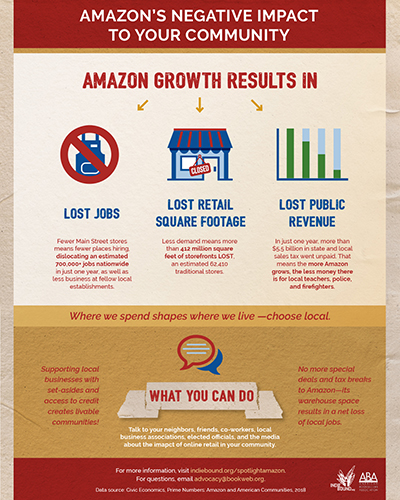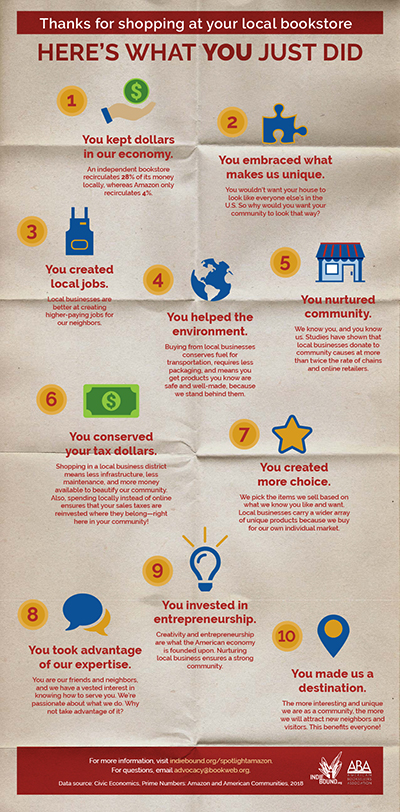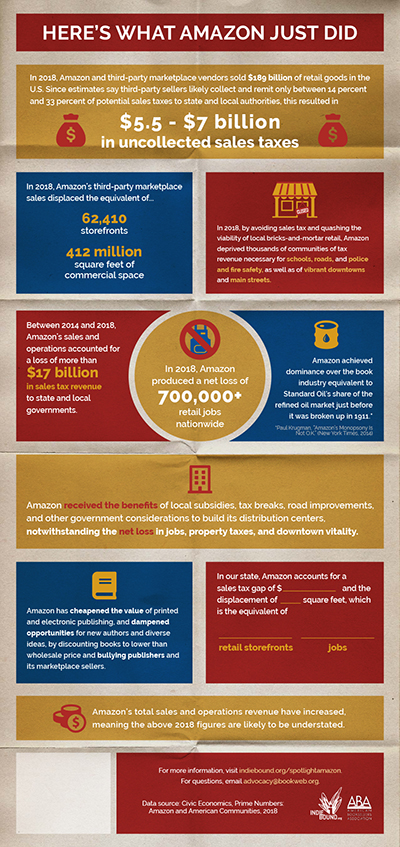Cost of Amazon
Shoppers spent $367 billion at Amazon in 2021. That’s $367 billion that could have gone to local business owners and recirculated into their communities through their vendors, employees donations, and local sales taxes. Buying from Amazon circulates just 5.8 percent of revenue into a local economy, but buying from a local, independently owned bookstore creates 4X more local economic activity than buying from Amazon. All that lost revenue could have funded public works, public safety, and public education.
Unfulfilled: Amazon and the American Retail Landscape was commissioned by the American Booksellers Association. The report concludes that the ongoing displacement of retail activity from traditional commercial spaces to outlying industrial parks is an emerging crisis for American cities and towns. “The routine gift of limited local resources to Amazon must stop, and the availability of good information and public pressure is likely the only way.”
Another study, Home Sweet Home: Locals vs. Amazon, demonstrates the significant economic benefit that supporting independent businesses has on local communities. The study, conducted by Civic Economics and commissioned by the North American Retail Hardware Association (NRHA), the Paint and Decorating Retailers Association, and Independent We Stand, specifically compares the impact of conducting business with independent hardware stores versus the sales of hardware and building materials through Amazon. It shows the substantial “local advantage” of indie stores over Amazon in terms of re-circulation of revenue back into the community.
Stacy Mitchell on Amazon's Stealth Invasion
Stacy Mitchell is co-director of the Institute for Local Self-Reliance and directs its Independent Business Initiative, which produces research and analysis, and partners with a broad range of allies to design and implement policies to reverse corporate concentration and strengthen local enterprise.
Here's What You Just Did
- You kept dollars in our economy. An independent bookstore recirculates 29.3 percent of its money locally, whereas Amazon only recirculates 5.8 percent.
- You embraced what makes us unique. You wouldn’t want your house to look like everyone else’s in the U.S. So why would you want your community to look that way?
- You created local jobs. Local businesses are better at creating higher-paying jobs for our neighbors.
- You helped the environment. Buying from local businesses conserves fuel for transportation, requires less packaging, and means you get products you know are safe and well-made, because we stand behind them.
- You nurtured your community. We know you, and you know us. Studies have shown that local businesses donate to community causes at more than twice the rate of chains and online retailers.
- You conserved your tax dollars. Shopping in a local business district means less infrastructure, less maintenance, and more money available to beautify our community. Also, spending locally instead of online ensures that your sales taxes are reinvested where they belong—right here in your community!
- You created more choice. We pick the items we sell based on what we know you like and want. Local businesses carry a wider array of unique products because we buy for our own individual market.
- You took advantage of our expertise. You are our friends and neighbors, and we have a vested interest in knowing how to serve you. We’re passionate about what we do. Why not take advantage of it?
- You invested in entrepreneurship. Creativity and entrepreneurship are what the American economy is founded upon. Nurturing local business ensures a strong community.
- You made us a destination. The more interesting and unique we are as a community, the more we will attract new neighbors and visitors. This benefits everyone!
Here's What Amazon Just Did
- In 2021, Amazon and third-party marketplace vendors sold $367 billion of retail goods in the U.S.
- In 2021, Amazon displaced the equivalent of 136,000 storefronts and a net 1.1 million square feet of commercial space.
- In 2021, by quashing the viability of local bricks-and-mortar retail, Amazon deprived thousands of communities of tax revenue necessary for schools, roads, and police and fire safety, as well as of vibrant downtowns and main streets.
- In 2021, Amazon produced a net loss of 1.7 million-plus retail jobs nationwide.
- Amazon received the benefits of local subsidies, tax breaks, road improvements, and other government considerations to build its distribution centers, notwithstanding the net loss in jobs, property taxes, and downtown vitality.
- Amazon's dominance over the book industry is greater than Standard Oil’s share of the refined oil market just before it was broken up in 1911.
- Amazon has cheapened the value of printed and electronic publishing, and dampened opportunities for new authors and diverse ideas, by discounting books to lower than wholesale price and bullying publishers and its marketplace sellers.
- Amazon isn’t involved in the communities where most of its customers live.
Sources: Civic Economics, Unfulfilled: Amazon and the American Retail Landscape, 2022.



